One of her country’s most celebrated artists, Schjerfbeck is little known in the UK, but now her singular paintings will seen in a major exhibition
In the seaside town of Ekenäs, south-west of Helsinki, there is a name that appears wherever you go: Helene Schjerfbeck. A street lined with early-19th-century weatherboard houses is named after her, and at the Helene Schjerfbeck cafe they serve lingonberry and bitter chocolate cake with the initials HS picked out in sugar. An actor, Anne Ingman, has made it her vocation to impersonate Schjerfbeck in a floor-length black costume with a battered leather handbag and a jade brooch like one Schjerfbeck wore. She guides visitors through a park where Schjerfbeck painted, tells stories about her life and points out a modern artwork by AK Dolven, a bell high in the oak trees that can be heard across town. Send not to know for whom the bell tolls: it is another homage to Schjerfbeck.
In Helsinki’s Ateneum, Finland’s national gallery, Schjerfbeck (1862-1946) has been, through the latter part of her lifetime and since her death, one of Finland’s best-loved artists. But in the UK she remains little known. This month, at the Royal Academy, a solo show of 65 paintings (she made more than 1,000 in her lifetime) is about to put this right. Schjerfbeck started in the style of French naturalists such as Jules Bastien-Lepage before becoming an early modernist. She is sometimes described, according to the Ateneum’s chief curator and co-curator of the Royal Academy show Anna-Maria von Bonsdorff, as “Finland’s Munch”, though at the same time she is “individual – distinctively herself” and not as histrionic as her Norwegian counterpart. Royal Academy assistant curator Rebecca Bray suggests that through the “intimacy and interiority” in her work, she has more in common with the Danish painter Vilhelm Hammershøi, sharing his melancholic grace.
Schjerfbeck was single-minded, ambitious, tending to the reclusive and yet a chic dresser with a keen interest in fashion. Her self-portraits are her most extraordinary achievement and she painted these throughout her life. She would underplay their relevance, breezily observing that they were produced for convenience (she was, after all, always available as a model). Von Bonsdorff laughs at this, sees it as a self-protective evasion – Schjerfbeck did not want to be an object of scrutiny and was determined to discourage curious visitors. But her self-portraits are an inquiry into mortality. They put her in the company of Goya, Rembrandt, Francis Bacon and Lucian Freud.
The self-portraits painted towards the end of her life, when she was dying of cancer in a sanatorium, show an understanding that a person is made up of everything they have ever been: she detects a youthfulness within age. By the time she is painting Green Self-Portrait: Light and Shadows (1945), you can see that dust will soon follow: the skull beneath the skin is visible, the shadow of death. Through the dissolution of precise features, she paints a ghost of her former self.
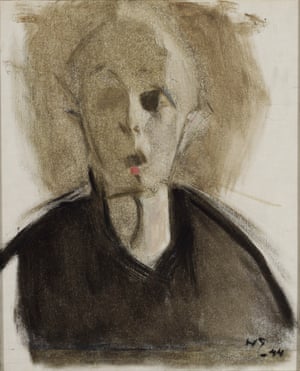
The power in these paintings, says Bray, is the sense of “coming face to face with the interior of someone who is very ill and yet, at the same time, has a continuing will to work”. Their inwardness fascinates: Schjerfbeck frequently paints herself (and others) with an averted gaze – the eyes escaping towards the skirting board or into the corners of a room. The displaced intensity is reminiscent of lines from an Emily Dickinson poem: “I cannot live with You – It would be Life – And Life is over there – Behind the Shelf.” The sense is that what matters is at an angle, at one remove – elsewhere.
Von Bonsdorff says Schjerfbeck never explained her preference for the averted gaze but believes it to be, in part, a further illustration of her need for privacy. In 1915, the Ateneum commissioned a self-portrait for an exhibition after a period during which she had felt ignored by the establishment. She was pleased to be the only female artist invited to participate (she was not a militant feminist but supported women’s suffrage – Finland was the first European country to give women the vote). In the resulting painting (used on the poster for the Royal Academy show), she has daubed herself with rouge and positioned a vermilion paint pot beside her. Her name is on the canvas, Holbein-style. It is a wan, authoritative and unnerving piece.
Helene Schjerfbeck was born on 10 July 1862 in Helsinki. It is said that her artistic life began when, aged four, she fell down the front steps of the family’s house and broke her hip. It was a bad break, inexpertly set, and left her with a limp for life. But it was while she was convalescing that her father gave her pencils and she started to draw. She later said: “When you give a child a pencil, you give her an entire world.” In her case, it was true and her talent would soon prove impossible to ignore.
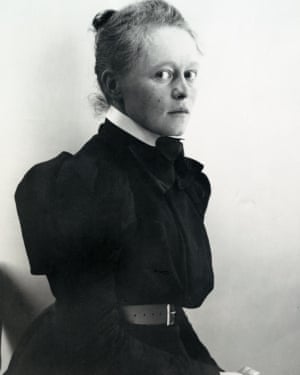
Even on a spring visit to Helsinki, where I travel to retrace Schjerfbeck’s steps, winter is never far off: icebreakers are sighted offshore and the handsome, stone apartments look built to withstand the cold (Schjerfbeck’s studio was high up in one of these buildings). In the early 19th century, fire destroyed medieval Helsinki – most buildings in the city are post-1819. And it is in the classical Ateneum, built in 1887, that an archivist shows me Schjerfbeck’s childhood sketchbooks with their humble, brown covers, full of astonishingly precocious drawings: delicate pencilled landscapes, gentle hands, painstakingly reproduced horses. On their final pages, like many a schoolchild with grand ideas, she rehearses her signature. Hs and Ss flourish their way into the future. The sense is that, even at this stage, she knew where she was going.
Schjerfbeck’s talent was spotted by a teacher when she was 11 and she won a scholarship to join the drawing school of Helsinki’s Finnish Art Society. Two years later, when she was 13, her father died of tuberculosis. The family had never been well off – Svante Schjerfbeck had started as a merchant, gone bankrupt, and became the office manager of a railway engineering workshop. His death devastated the family. Olga, Helene’s mother, took in lodgers – and sewing – to make ends meet but never thought art a suitable career for her daughter. It was her father who had always been Helene’s great supporter.
Fortunately, there were others who wanted to help. Finland had been part of Sweden until it was annexed in 1809 by Russia and did not become independent until 1917. And, as Helene became a teenager, the country was recruiting talent to establish a national identity through art. She was granted a further scholarship to study oil painting at the academy of German-born painter Adolf von Becker from 1877 to 1880. At 16, too young to show her work in Paris, she studied plein-air realism and history painting and, in 1879, produced the painting that would launch her career.
Wounded Warrior in the Snow (in the Ateneum’s collection) is formidably accomplished for a 17-year-old, remarkable for its (albeit carefully staged) naturalism. The military subject treated in a non-bellicose way was a rarity. And female artists at this time were more likely to be turning out floral still lifes. This is a still life of another sort: against a snowy silver birch a soldier slumps, a rifle in his left hand, his booted legs outstretched, no help in sight. It is possible to make out tiny figures to the right of the canvas, but whether they are advancing or retreating, it is hard to say. It is said that Schjerfbeck was painting her own situation – abandoned by her teacher and older students as they went off to exhibit in Paris without her. If this was the case, it is pleasing to discover that this painting about abandonment would secure her a grant from the Finnish senate to travel eventually to Paris, on a Kiel steamer then onwards by train.
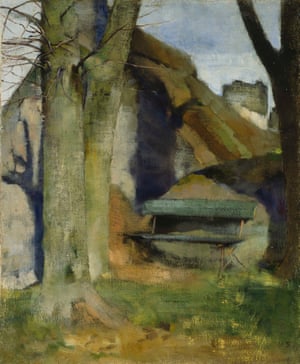
Throughout her life, Paris remained her dream city. There she lived the life of an artist: slept in a garret, worked hard and made lifelong friendships with Helena Westermarck, Maria Wiik and Ada Thilén, whom she called målarsystrarna, her “painter sisters”. And, over a 10-year period, she went on to work in Brittany, Florence and St Ives in Cornwall.
It was in St Ives that Schjerfbeck produced her most popular work, The Convalescent (1888). But the background to this painting is a story she never wanted told. A modern biographer would struggle with Schjerfbeck – she left so much to the imagination (no wonder she is the subject of several Finnish novels, and – next year – both a film and an opera). All that is known, from family records that have, against the odds, survived is that between 1883 and 1884, her heart was broken. Her lover was an artist, damningly referred to in Finland as “the Englishman” (although some academics, I’m pleased to report, now maintain he was Swedish). They met in Pont-Aven in Brittany (might he, after all, have been French?). Whatever his nationality, no one now knows his name. He wrote a letter to Helene calling off their engagement, justifying himself by saying she was not, in his opinion, strong enough to bear his children. She destroyed the letter and asked friends – who wholeheartedly complied – to burn any correspondence in which his name was mentioned. She would never have children and although it is said she wished she could adopt, she feared she might not be physically strong enough (might the Englishman have been to blame?).
His defection was the reason behind her trip to St Ives to stay with her friends, the painters Adrian Scott Stokes and Marianne Preindisberger Stokes (she had become friends with the latter in Paris). The Convalescent was the result. A small girl, with tousled hair, leans forward in a wicker chair, half-wrapped in a sheet. On the table in front of her is a sprig, starting to sprout, in a blue-and-white mug. Books prop each other up on the shelves behind her. The feeling is of absolute quiet, of fevered trance. The child is lost in the artist’s world. Recovery, not decline, is the subject. The six-year-old is said to have been so lively that her teacher was delighted to offload her on to Schjerfbeck for sittings.
To a modern eye, the painting seems traditional but, first presented in Finland, it was deemed, according to Anna-Maria von Bonsdorff, “too modern, not polished enough, too French”. Unsurprisingly, the French liked it: it won a bronze medal in Paris and was bought by the Ateneum and has been a favourite with gallery-goers ever since. Anna-Maria von Bonsdorff says: “It is the subject that draws people because it is about hope – an unusually positive picture in modern art.”
She contrasts it favourably with Munch’s The Sick Child (1907), a painting of his sister who died of tuberculosis. Schjerfbeck’s patient has a playful eye. Might the painting be autobiographical twice over – referring not only to recovery from a painful affair but to Schjerfbeck’s own childhood convalescence?
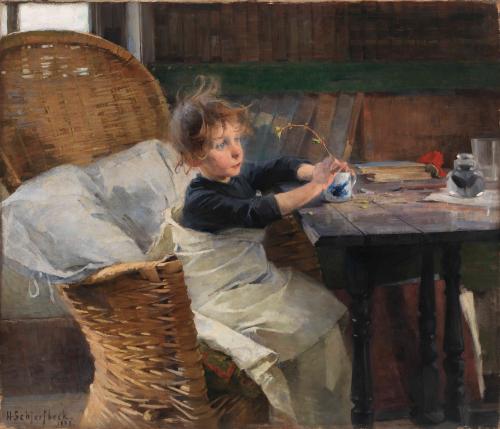
At the age of 30, Schjerfbeck boosted her income copying masterpieces for museums (finding inspiration in the work of Holbein, el Greco, Diego Velázquez). And, in time, the influential gallerist and art dealer Gösta Stenman gave her a small salary in return for free access to her work. Her financial affairs were managed by her brother Magnus (not always to her liking), and she taught for two years at the Art Society drawing school. Her students appreciated her but she disliked teaching and was relieved, in 1902, to move to Hyvinkää, a town 30 miles north of Helsinki, to look after her mother.
It is impossible to look at the portraits of Schjerfbeck’s mother painted in Hyvinkää (three are on show at the Royal Academy) without speculating about their relationship. Olga lost a child before Helene was born and, it seems, never bonded with her daughter. In the 1902 portrait, Olga sits in a rocking chair outdoing Whistler’s mother (Schjerfbeck knew and admired Whistler but did not like being compared with him). You can barely see her face – you can just make out the rim of her glasses. She is reading, ominously enough, what appears to be a blank book. Were she offering us a message, it might be that she has better things to do than catch our eye.
Olga wished her daughter would dabble rather than devote herself to painting – art got in the way of housework. But the Schjerfbecks had the luxury of a maid and neither mother nor daughter cooked. Errand boys and girls were dispatched to bring home meals from the railway station restaurant – early 20th-century takeaways.
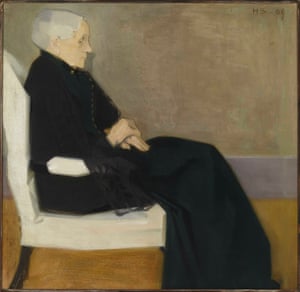
After her mother’s death in 1923, Schjerfbeck moved to Ekenäs. She chose Ekenäs (Tammisaari to Finnish-speakers) because she had aunts there and the town was Swedish-speaking. She did not speak much Finnish herself (many people on the south-west coast of Finland have Swedish as their mother tongue). There is a famous photograph of her taken in Ekenäs park – the only image in which she is smiling. It is not an established smile; you can see the photographer must have coaxed her into it. The picture was taken by Einar Reuter – writer, forester, amateur painter and great admirer of her work. He even wrote a short biography of her. She was 52 when they met. He was 18 years younger. And he was (although no one knows exactly how their relationship evolved) the second love of Helene Schjerfbeck’s life.
In 1918, Einar sailed to Ekenäs from Helsinki and this led to her first painting of him The Sailor. It is, aside from the self-portraits, one of her finest pieces. The young man is bare-chested – tanned – with a languid turn of the head, a cleft chin, a blond moustache. It was commonplace to see paintings of women lying naked on divans, but not a sensual portrait of a man. The painting was exhibited only twice in Finland, in 1918, and never again in Schjerfbeck’s lifetime.
Painting was, perhaps, a substitute for possessing – at any rate, it seems likely there was no affair of the flesh. Instead, the besotted Helene paid for Einar to visit a Norwegian sanatorium (Finns of this era were dedicated sanatorium-goers, obsessed with their health-giving properties) and, on the trip, Einar boosted his health by becoming engaged to a woman 20 years his junior. Schjerfbeck believed she would not survive the news (she even made her will). But when they eventually patched up their friendship, she went on to paint a second portrait (1919-20) in contrast to the first. The “sailor” has gone. This painting is simply entitled Einar Reuter. The moustache continues to thrive, the chin remains cleft, but the eyes register nothing – two dead circles of paint. It is the end of an affair that (probably) never was.

The years spent in Ekenäs overlapped with Finland’s brief but brutal civil war – it is an unsettling tale of two towns. Schjerfbeck loved the peace, calm waters and trees of Ekenäs, but while she painted in the park, thousands of prisoners were being held in a concentration camp outside the town. She mentions them in letters but their situation seems scarcely to have impinged on her parallel painterly universe. As she wrote, unswervingly, to a friend: “To work, to live through work, that is my path.”
Schjerfbeck spoke English, French and German and was a great reader – she loved Oscar Wilde and Robert Burns and is known to have been particularly enthusiastic about a biography of Van Gogh. But perhaps the most incongruous of her enthusiasms – given her seriousness – was for fashion. She adored French fashion magazines, flapper dresses, hats worn at a jaunty angle. She bought clothes, mail order, from Galeries Lafayette in Paris. From the photographs, you can see she wore knock-’em-dead garb especially during the period during which she first knew Einar. She looks elegant yet defended in a high collared dress with gathered cuffs and tiny, exquisite buttons and a brimmed hat. One suspects that fashion offset Nordic darkness.
Several wonderful portraits show the tête-à-tête between fashion and art. In Girl With Beret (1935), the model wears a beret at a coquettish angle and a pink blouse – but it is the patches of sunlight illuminating her contemplative face, almost turning it into an abstract, that make a success of the painting. Scherfbeck’s fashion plates go deep. Another striking painting is of her favourite model, Dora Estlander: Elegant Lady (1928). She has a chic androgyny: a curious, greenish complexion, a tiny daub of rouge on her left cheekbone, a hangdog droop to her features, a fashionably elongated giraffe neck, a look of mild consternation at being herself. It is a painting that gestures in Modigliani’s direction. Schjerfbeck never painted a commissioned portrait. Her models were people she knew: her landlord, her landlord’s children, local women, her mother, herself. She preferred not to show models her paintings of them – the likenesses – or the unlikenesses.

The older she became, the more she prized simplicity. As guest curator Jeremy Lewison writes, she started “favouring memory over direct observation and the general over the particular”.
Some of the extraordinary late still lifes coming to the Royal Academy verge on the abstract. In Still-life with Blackening Apples (1944), ripeness is not all – the fruit on the right hand side is black already – fruit only just holding its own as fruit. There is a life-and-death beauty to it, an unexpected brilliance. One acidly green apple is startlingly reflected by the surface upon which it lies. It asks for only the smallest of imaginative leaps to link these still lifes with the late self-portraits. “We always hang them together,” says von Bonsdorff. “Schjerfbeck said, more than once, that when she became too involved with a portrait, she would break off to do a still life. She found a freedom in still lifes that allowed her to return to people.”
This simplicity is at its most extreme and moving in her last self-portrait – a charcoal sketch made in 1945. It is a memento mori, a drawing that looks like a carving. Her face has been reduced to the most essential version of itself, made as if with the strokes of a knife. The mouth is a single line, the eyes unreadable – the portrait is a closing down, the ultimate still life. Helene Schjerfbeck at once acknowledges death and defies it in work she must have known would survive her.
The Helene Schjerfbeck exhibition is at the Royal Academy of Arts, London, from 20 July to 27 October.
